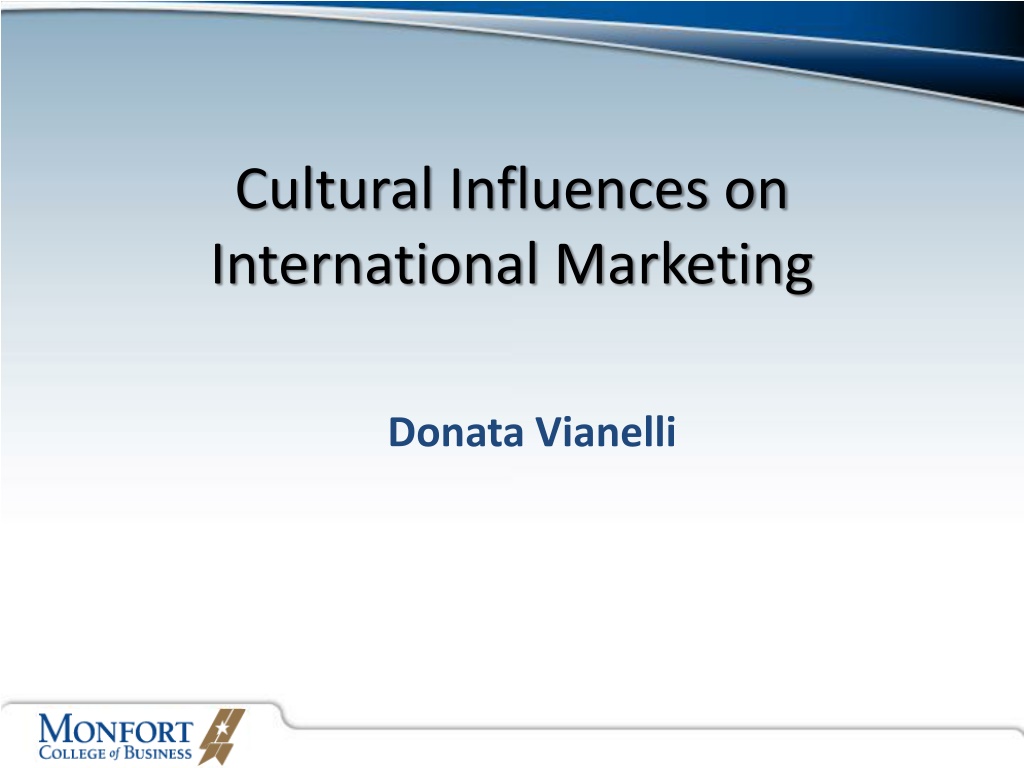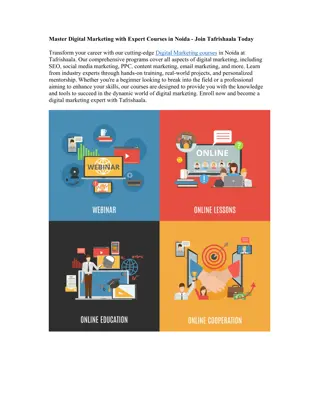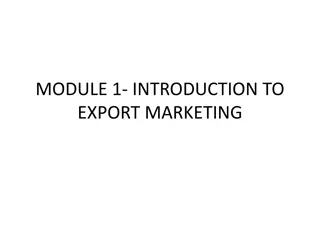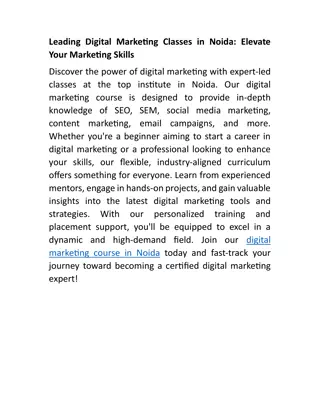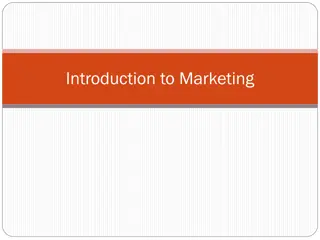Understanding Cultural Influences on International Marketing by Donata Vianelli
Explore the impact of culture on international marketing, covering elements like language, religion, values, and norms. Delve into cultural dimensions, subcultures, and challenges like translation in marketing practices worldwide.
Uploaded on Oct 10, 2024 | 0 Views
Download Presentation

Please find below an Image/Link to download the presentation.
The content on the website is provided AS IS for your information and personal use only. It may not be sold, licensed, or shared on other websites without obtaining consent from the author. Download presentation by click this link. If you encounter any issues during the download, it is possible that the publisher has removed the file from their server.
E N D
Presentation Transcript
Cultural Influences on International Marketing Donata Vianelli
Chapter Objectives Identify elements of culture and examine how they affect international marketing practices around the world. Describe national and regional character based on dimensions such as time orientation, business practices, gift giving, socializing, gender roles, and materialism. Discuss cultural variability in terms of the Hofstede dimensions with appropriate examples and address cultural change in a marketing context. Address the self-reference criterion and ethnocentrism and describe how they impede mutual understanding and cooperation, with direct negative effects on marketing practices. Describe the global consumer culture as it manifests itself around the world.
Culture Culture is defined as a continuously changing totality of learned and shared meanings, rituals, norms, and traditionsamong the members of an organization or society. Culture is also defined as a society s personality.
Subcultures Dal Quirinale panoramica su Roma col Cupolone di San Pietro - Foto 2008 Valeria Lenzi Bonfiglioli Rome Milan Naples
Elements of Culture The main elements of culture are: Language Religion Cultural values Cultural norms
Elements of Culture: Language Spoken/Written Language Same word, different meanings Poses a number of concerns to marketers: - It creates difficulties in terms of correct translation - Marketers may experience dilemma in unified markets where multiple languages are used as to which language(s) to use (India with more than 3000 dialects) - High costs of translation. - Language and target (for example, foreigners living in the United Arab Emirates) - Written language convey meanings (n 4)
Problems of translation For example, the Chinese translation proved difficult for Coke, which took two tries to get it right. They first tried Ke-kou-ke-la because when pronounced it sounded roughly like Coca-Cola. It wasn't until after thousands of signs had been printed that they discovered that the phrase means "bite the wax tadpole" or "female horse stuffed with wax", depending on the dialect. Second time around things worked out much better. After researching 40,000 Chinese characters Coke came up with "ko-kou-ko-le" which translates roughly to the much more appropriate "happiness in the mouth". http://www.takingontobacco.org/intro/funny.html
Elements of Culture: Language (contd.) Nonverbal communication Proxemics: The relationship between physical space and the process of communication (distance between people in the communication process) Postures, orientations, and oculesics: Individuals' positioning relative to their counterpart and the use/avoidance of eye contact during communication. Chronemics: The timing of verbal exchanges in a conversation with others. Haptics: The use of touch while conversing. Kinesics: Movements of parts of the body to facilitate communication, such as gesturing. Paralinguistics: Non-verbal aspects of speech, including emotional intonation, accents, and the quality of voice. Appearances: One's physical attire and overall grooming. Olfactions: Use of odors to convey messages, whether religious or personal. For example, not in all countries body odor is offensive
Non verbal language: High versus Low context cultures Low context cultures (US, Canada, Germany, Switzerland What is said is precisely what is meant: the verbal message carries the full meaning of the sentence. Limited non verbal language. High context cultures (East Asia, Middle East, Central and Southern Europe ) The message source, his or her standing in society or in the negotiating group, level of expertise, tone of voice and body language: everything is meaningful. Relationship are highly valued, trust is crucial.
Elements of Culture: Religion Defines a society's relationship to the supernatural. Determines dominant values and attitudes. Religious beliefs are important determinants of consumer behavior and can be linked to cultural behaviors that impact economic development and marketing. 11 Chapter 5
Religion and Its Impact on Business Religion and business days: Dominant religion determines prayer time, the time for fasting, and creates restrictions on businesses. Religion and gender roles: Differ from country to country for example, in traditional Islamic countries, women s business activities are restricted to a women-only environment, and genders do not interact outside the family. Religion and gift giving: Marketers must be aware of religious holidays as gift-giving events. Religion and marketing practices: Firms often must adapt their offering to the local culture to address consumers' religious concerns. Firms must also advertise according to the norms in certain cultures for example, avoiding to portray women in Saudi Arabia. 12 Textbook Media Press Chapter 5
Elements of Culture: Cultural Values Values are enduring beliefs about a specific mode of conduct or desirable end-state. They guide behavior and are ordered by importance in relation to one another, thus forming a system of value priorities. Because they guide individuals' actions, attitudes, and judgments, cultural values affect consumer product preferences and perception of products. Some exemples: China Shampoo Ad - Values of Success and Strength: http://www.youtube.com/watch?v=imWeRR2GtxU 13 Textbook Media Press Chapter 5
Learning New Cultures Enculturation Process by which individuals learn the beliefs and behaviors endorsed by one s own culture. Acculturation Learning a new culture. Assimilation Full adoption and maintenance of the new culture, and resistance to one s old culture. 15 Textbook Media Press Chapter 5
Elements of Culture: Cultural Norms Norms are derived from values and defined as rules that dictate what is right or wrong, acceptable or unacceptable. Imperative - What an outsider must or must not do. Exclusive - What locals may do but an outsider cannot do. Adiaphora - What an outsider may or may not do. 16 Textbook Media Press Chapter 5
National/Regional Character Time orientation: Monochronic time (M-time) attributed to cultures where individuals usually do one thing at a time, sequentially. Polychronic time (P-time) attributed to cultures where individuals perform multiple tasks at once, and tend to see time as fluid. Business hours, business days: Business do not operate: on Sundays in Christian countries, on Fridays in Muslim countries, and on Saturdays, in Israel. Gift giving: Knowing what gifts are appropriate, along with the manner in which they should be presented is essential. 17 Textbook Media Press Chapter 5
National/Regional Character (contd.) Socializing: Appropriate conversations, talking business at dinner, etc. Gender roles: Gender roles and role-related expectations are important when establishing business relationships. Status concern and materialism: Familiarity with consumer concern for acquisitions and social status helps marketers determine appropriate marketing strategies. 18 Textbook Media Press Chapter 5
Other Manifestations of National and Regional Character Contact e.g., phone, e-mail, in person. Access e.g., transportation by bicycle, personal automobile, public transportation. European and Asian consumers are more likely to travel by bicycle 19 Textbook Media Press Chapter 5
Cultural Variability Term used to differentiate between cultures on the Hofstede Dimensions, which are: Power Distance: this dimension expresses the degree to which the less powerful members of a society accept and expect that power is distributed unequally (Hofstede) Your book: the manner in which interpersonal relationships are formed when there are perceived differences in power. U.S. Germany China High Low 20 Textbook Media Press Chapter 5
Cultural Variability (contd.) Uncertainty Avoidance - The extent to which individuals are threatened by uncertainty and risk and thus adopt beliefs and behaviors that help them to avoid the uncertainty. U.S. China Low High 21 Textbook Media Press Chapter 5
Cultural Variability Masculinity/Femininity - Hofstede: The Masculinity side of this dimension represents a preference in society for achievement, heroism, assertiveness and material rewards for success. Society at large is more competitive. Its opposite, femininity, stands for a preference for cooperation, modesty, caring for the weak and quality of life. - The extent to which a culture is characterized by assertiveness, rather than nurturing. United States Sweden High Low Masculinity Masculinity 22 Textbook Media Press Chapter 5
Cultural Variability (contd.) Individualism/Collectivism - The extent to which individuals prefer to act in the interest of the group rather than in their own self- interest. United States Thailand Low High Individualism Individualism 23 Textbook Media Press Chapter 5
High vs. Low Context Cultures Low-Context cultures: What is said is precisely what is meant. High-Context cultures: The context of the message is meaningful Context: Message source is important: - The source s standing in society or in the negotiating group. - The source s level of expertise, tone of voice, body language. 24 Textbook Media Press Chapter 5
Cultural Change and Marketing Marketers need to integrate culture when designing a marketing strategy by going through the following process: Researching symbolic elements and cultural meanings in consumers lives Identifying cultural meanings of the product Designing the product accordingly Designing the marketing campaign using symbolic cultural elements 25 Textbook Media Press Chapter 5
Obstacles to Cultural Understanding Ethnocentrism The belief that one s own culture is superior to another and that strategies that are used in the home country will work just as well internationally. The Self-Reference Criterion: The unconscious reference to one s own national culture, to home-country norms and values, and to their knowledge and experience in the process of making decisions in the home country. 26 Textbook Media Press Chapter 5
Global Consumer Culture Defined in terms of shared consumption-related symbols and activities that are meaningful to market segments; attributed to the diffusion of Western products to the rest of the world. - Entertainment (MTV, movies, CD s) - Hamburgers and pizza - Jeans and running shoes, etc. 27 Textbook Media Press Chapter 5
Global Consumer Culture Trends Proliferation of transnational firms and the related globalized capitalism. Globalized consumerism and the desire for material possessions. Homogenization of global consumption. - Referred to McDonaldination or Cocacolonization 28 Textbook Media Press Chapter 5
Positioning Based on Culture Three alternatives: Global consumer culture positioning - Positioning the product to appeal to individuals who want to be part of a global consumer culture. Local consumer culture positioning - Positioning the product so that it is associated with local cultural meanings. Foreign consumer culture positioning - Positioning a products as symbolic of a desired foreign culture (e.g., French perfume, Andean folk music, etc.). 29 Textbook Media Press Chapter 5
